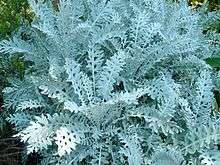Centaurea cineraria
Centaurea cineraria, the velvet centaurea, is – like some other plants – also known as dusty miller and silver dust. It is a small plant in the family Asteraceae and originates from the Island of Capraia in Italy, where it is called fiordaliso delle scogliere.[3]
| Centaurea cineraria | |
|---|---|
 | |
| Scientific classification | |
| Kingdom: | |
| (unranked): | |
| (unranked): | |
| (unranked): | |
| Order: | |
| Family: | |
| Tribe: | |
| Genus: | |
| Species: | C. cineraria |
| Binomial name | |
| Centaurea cineraria | |
| Synonyms | |
| |
The mature plants will grow from 15 cm to 60 cm (6 inches to 24 inches). They prefer full sun, but will tolerate light shade, and also prefers average to rich well-drained soil.
Centaurea cineraria will produce small white or yellow flowers in summer, but these are usually trimmed because the plant is normally grown as foliage.
Depending on climate, it can be grown as either an annual or as a perennial.
C. cineraria is polymorphic in several characters, and the high variation within populations gives rise to many subspecies which causes C. cineraria to be referred to under a wide variety of different synonyms.[5]
Common cultivars include:'Silver Dust', 'Silver Lace' and 'Cirrus'. The image above the scientific classification is a plant of the 'Silver Lace' cultivar.
C. cineraria is sometimes referred to as Centaurea gymnocarpa, as a hybrid species between the two is used in gardens as an ornamental plant. However in the wild, the two may be considered different species.[6]
In the UK Centaurea cineraria subsp. cineraria has gained the Royal Horticultural Society's Award of Garden Merit. [7]
References
- Euro+Med Plantbase lists Centaurea gymnocarpa as an accepted species, while the Global Compositae Checklist lists it as a synonym of Centaurea cinerea. The IUCN Red List of Threatened Species, Version 2014.1, states "C. gymnocarpa belongs to the ... "cineraria" group ... probably was once a single species, ... but as islands were formed, new species evolved on each island."
- "Centaurea cineraria". Germplasm Resources Information Network (GRIN). Agricultural Research Service (ARS), United States Department of Agriculture (USDA). Retrieved 2008-03-03.
- Botanic Garden and Botanical Museum Berlin-Dahlem. "Details for: Centaurea cineraria". Euro+Med PlantBase. Freie Universität Berlin. Retrieved 2008-03-03.
- All. Fl. Pedem. 1: 163 1785
- Domina, Gianniantonio; Greuter, Werner; Raimondo, Francesco M. (March 2016). "Types of names of taxa belonging to theCentaurea cinerariagroup (Compositae) described from Sicily". Willdenowia. 46 (1): 23–26. doi:10.3372/wi.46.46102. ISSN 0511-9618.
- "Centaurea gymnocarpa: Foggi, B." IUCN Red List of Threatened Species. 2006-01-31. Retrieved 2020-04-23.
- "Centaurea cineraria subsp. cineraria". www.rhs.org. Royal Horticultural Society. Retrieved 12 April 2020.
- Cela Renzoni G, Viegi L.. 1983. Centaurea cineraria s.l. (Asteraceae) in Italia: revisione citotassonomica.. Atti della Società Toscana di Scienze Naturali. Memorie serie B, 89: pp. 99–144. Società Toscana di Scienze Naturali, Pisa.
- Ellis, Barbara W., "Taylor's Guide to Annuals, How to Select and Grow More Than 400 Annuals, Biennials, and Tender Perennials", 1999 Haughton Mifflin Company, New York, NY
- Armitage, Allan M., "Armitage's Manual of Annuals, Biennials, and Half-Hardy Perennials", illustrated Asha Kays and Chris Johnson, 2001 Timber Press Inc., Singapore